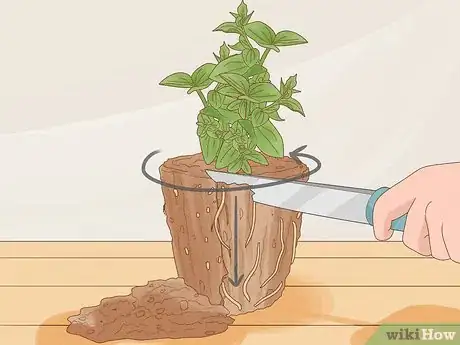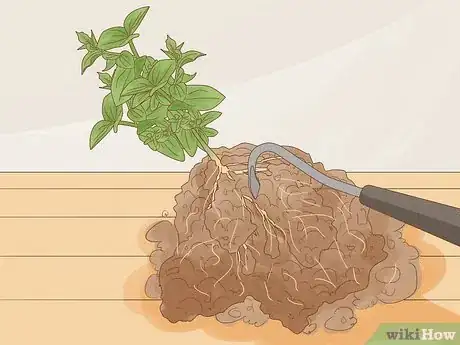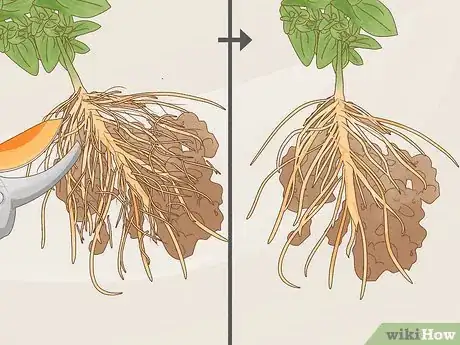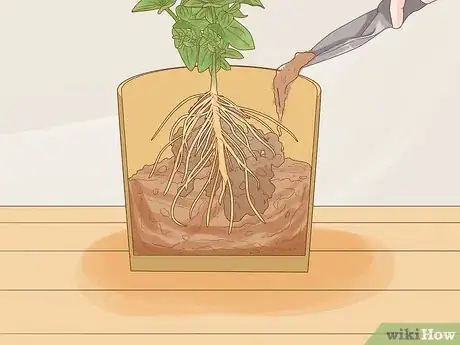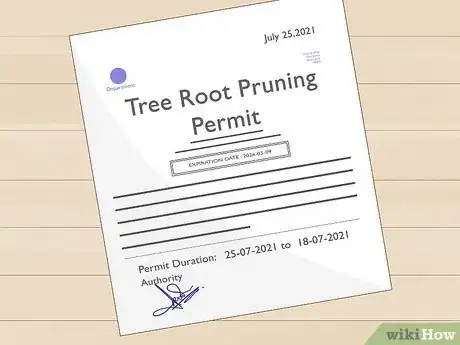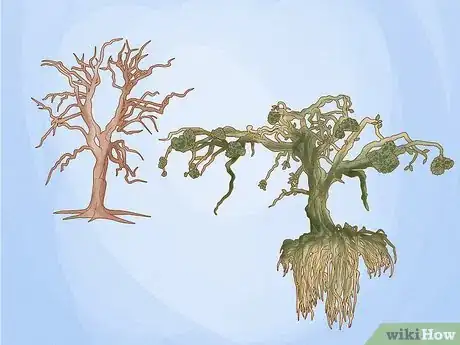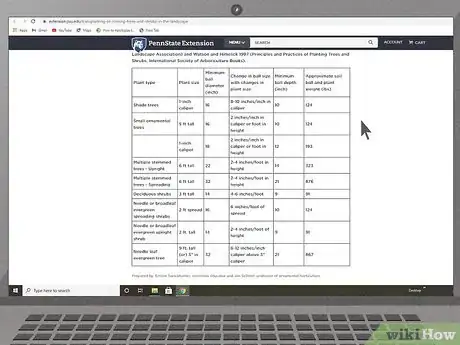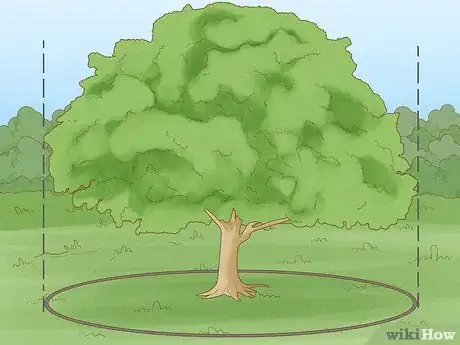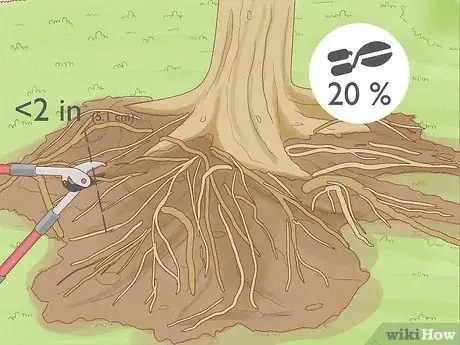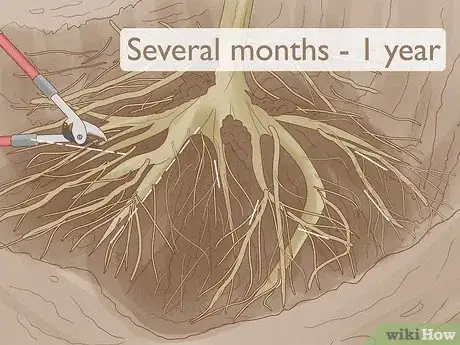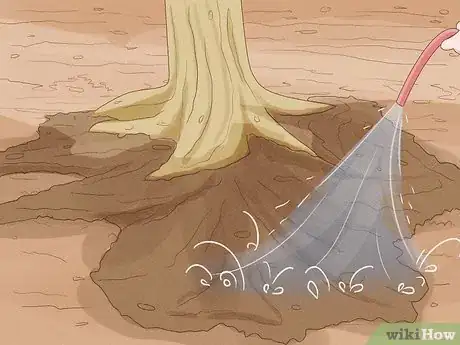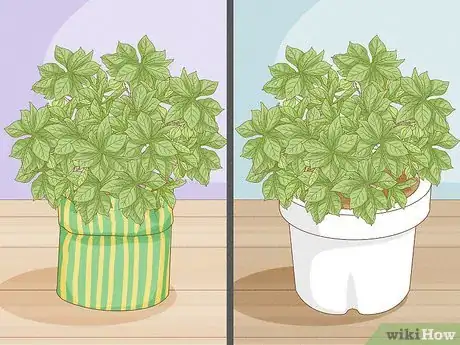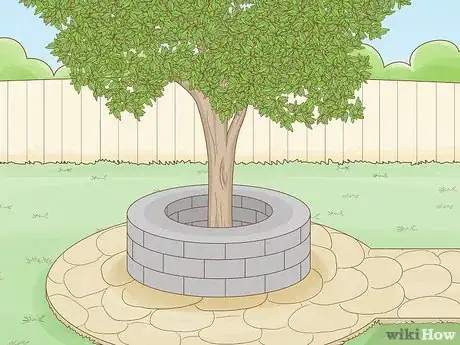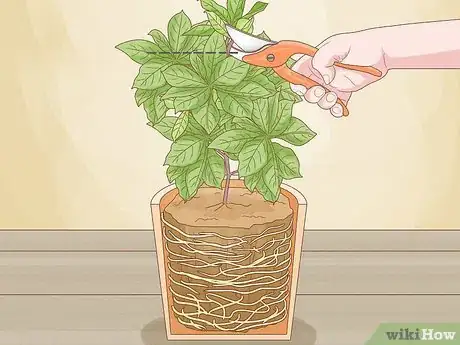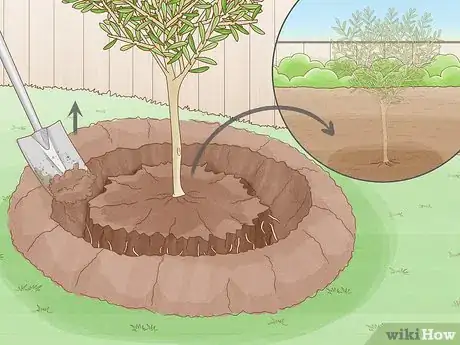This article was co-authored by Chai Saechao and by wikiHow staff writer, Jennifer Mueller, JD. Chai Saechao is the Founder and Owner of Plant Therapy, an indoor-plant store founded in 2018 based in San Francisco, California. As a self-described plant doctor, he believes in the therapeutic power of plants, hoping to keep sharing his love of plants with anyone willing to listen and learn.
There are 10 references cited in this article, which can be found at the bottom of the page.
This article has been viewed 55,780 times.
While pruning the roots of a plant or tree may sound scary, it's actually quite common. If done properly, root pruning can improve the plant's growth and overall health. Container plants can become "pot-bound," with tight circular roots that can't get enough nutrition and will eventually kill the plant. Trees and shrubs planted outdoors also benefit from root pruning, especially if you're planning on transplanting them to a new location.[1]
Steps
Pruning Container Plants
-
1Remove the plant from its pot. Turn the pot upside down (or on its side, if it's a large pot that's too heavy for you to hold in one hand) and smack the bottom of the pot 2 or 3 times. The plant should come out of the pot cleanly.[2]
- You can also hold the pot with both hands and tap the edge against a potting bench or other sturdy surface. Just be careful not to break the pot. You may end up with quite a mess, so you may want to cover the ground in a tarp or garbage bag beforehand.
- If you notice soil drying up quickly, or roots growing through the drainage holes, it's a sign that your container plant needs to have its roots pruned and be repotted.
- When a plant is completely rootbound, watering the root ball thoroughly before removing the plant can help it come out more easily.
-
2Cut away the outer soil and roots. Using a sharp gardening knife or pruning shears, carefully cut away the outer, circular growth of roots and soil. Make sure your tool is sharp, so all the cuts you make are clean.[3]
- Stick to the thin, non-woody feeder roots. Avoid cutting any taproot, corm, or bulb your plant has, or the plant will die. Cutting through the outer roots growing in a circular pattern will keep the plant from strangling itself as it grows.
- Take time to evaluate the health of the roots. They should be light-colored and fresh smelling. If they have a foul smell or darker color, it could indicate fungal disease or other serious problems with your plant.[4] Look for fungi growth, and apply a fungicide. It could take months or even years to restore your plant.[5]
Advertisement -
3Loosen up the root ball. Use a single-prong or single-tine cultivator to loosen up the root ball. Rootbound plants may take some work, especially if the roots are tightly packed. Take care not to actually cut any roots as you're loosening up the root ball.[6]
- You can also untangle the roots gently with your fingers. This may be more appropriate than using a gardening tool with much smaller plants.[7]
-
4Trim off up to a third of the root ball as necessary. After you've sufficiently loosened the root ball, trim the thin feeder roots from the bottom using pruning shears. The amount of roots you need to trim depends on the space in your container and the size of the plant. There should be room for 1 to 2 inches (2.5 to 5.1 cm) of soil on the bottom, top, and all sides of the root ball.[8]
- Make 3 or 4 vertical cuts around the outside of the remaining root ball, starting at the bottom of the root ball and stopping about a third of the way up. This helps discourage future circular growth.
-
5Repot your plant at the same depth. Once you've pruned the roots, add new soil before returning your plant to its container. You may also want to add fertilizer to give your plant the nutrients it needs to grow new roots.[9]
- New roots absorb nutrients better than old roots, so don't add as much as you did in the past or you risk over-feeding your plant.
- Water your plant immediately after repotting it. Monitor the moisture level daily, since the roots may absorb more water in the first few days after being pruned.
- If your plant shows signs of shock, such as yellow foliage or stunted growth, move it out of direct sunlight and give it a few days' time to recover.
Pruning Tree and Shrub Roots
-
1Get a permit if necessary. If you need to prune the roots of a tree or shrub on public land, you may need to get a permit from your local government authority. There typically isn't a fee for a root pruning permit. Contact your local government to find out what you need to do.[10]
- In some locations, your local government will send out a professional to evaluate the tree and prune the roots if necessary. In others, you can do it yourself.
- If the tree or shrub (and its roots) exist entirely on your private property, you typically don't need a permit. If it's close to your boundary line, you may want to talk to your neighbors about it first.
-
2Evaluate the health and condition of the tree. If a tree is old, or in poor health, you generally shouldn't prune its roots. These trees are more likely to be severely stressed by root pruning, and could die as a result.[11]
- Avoid pruning the roots of a tree that is leaning. You could damage its stability and cause it to fall over.
- Look at soil conditions as well. Root pruning can cause more damage if the soil is shallow or drains poorly.
-
3Consult a professional arborist. An experienced arborist can give you advice on where, when, and how to prune a tree's roots. They can also let you know whether you can safely do it yourself. An arborist's opinion is particularly important if you're planning on moving a tree to a new location.[12]
- If you're planning on hiring a professional to do the work for you, talk to 2 or 3 different companies before you make a final decision. Ask about their experience and contact references. Make sure they have necessary licenses and bonding or insurance.
-
4Determine the adequate root ball size. If you prune the roots too aggressively, you risk damaging or killing your tree or shrub. Generally, the size of the root ball increases incrementally as the size of the tree or shrub increases. Different types of trees and shrubs also have different minimum root ball sizes. Adequate root ball size is particularly important if you're transplanting the tree or shrub.[13]
- The Penn State Agricultural Extension has a table of minimum root ball diameters of several common types of trees and shrubs available on its website. Go to https://extension.psu.edu/transplanting-or-moving-trees-and-shrubs-in-the-landscape to review the list.
-
5Mark the drip line. Trees have roots for stability as well as for feeding. When the tree is in full foliage, estimate the line where leaves or branches would drip water onto the ground. Roots growing from this line towards the trunk of the tree are necessary for the tree's health and stability.[14]
- Generally, roots within the drip line are stability roots. Pruning them may destabilize the tree, causing it to lean or fall.
-
6Remove no more than 20 percent of above-ground roots. Prune small roots using a sharpened spade. Take care to prune as few roots as possible. Pruning away more than 20 percent of the roots of a tree or shrub may put it under stress, leaving it weakened and vulnerable to pests.[15]
- Make sure any spade or other gardening tool you use is sharp, so you don't risk damaging the remaining root. Your cut should be clean.
- Don't prune any roots that are greater than 2 inches (5.1 cm) in diameter. These are most likely stability roots, and could cause the tree or shrub to fall over in high winds.
-
7Prune feeder roots underground before transplantation. Generally, there's no need to prune underground roots of trees or shrubs that will remain in the same place. However, if you're planning to transplant the tree or shrub to a different location, pruning feeder roots several months to one year before the move can reduce the shock to the tree or shrub.[16]
- Pruning the roots encourages the tree or shrub to grow new feeder roots. These roots will be younger, healthier, and more resilient to transplantation.
-
8Ensure adequate moisture after pruning roots. Particularly if you pruned the roots of your tree or shrub during a dry fall or winter season, make sure the soil surrounding the tree or shrub is watered thoroughly. This will encourage the tree or shrub to grow fresh new roots.[17]
- Check the soil's moisture daily, especially if you don't get rain often. The top 2 to 3 inches (5.1 to 7.6 cm) of soil should be moist to the touch.
- You might also mulch around the tree or shrub to help hold in the moisture, as well as protect the pruned roots, while your plant recovers.
Exploring Alternatives to Root Pruning
-
1Choose a container that will prune roots for you. Root pruning can be time-consuming and difficult. Roots naturally stop growing when they come into contact with light or air. Air pruning or light pruning containers help keep the roots in check so that root pruning isn't necessary.[18]
- Fabric pots allow roots to come into contact with air when they reach the edge of the container.
- White-colored containers don't block light, so when your roots reach the outside of the soil, they come into contact with light and stop growing.
-
2Design buildings and paths around plants and trees. If you have established plants and trees that are getting in the way of a project, you may be able to design around them. This helps preserve plant life and maintains the character of the landscape.[19]
- For example, you can raise a pathway to sit over top of roots, leaving a hole for the tree or shrub to grow through.
- You may also want to build structures further away from established trees and shrubs. This not only protects the plant's root system, it protects the structure as well.
-
3Prune the top of the plant. If a container plant is root-bound, it may lose moisture quickly. Top pruning means there is less plant for the roots to feed. The plant will be able to store and maintain moisture more effectively.[20]
- The same principle applies to outdoor plants. Cutting back growth can keep the plant healthier and more stable.
-
4Remove trees from the landscape entirely. If there is no way to adequately prune the roots of a tree that will stop the damage to buildings or infrastructure, the only solution may be to remove the tree permanently.[21]
- You may be able to have the tree transplanted to a different location. Consult a professional arborist, especially if the tree is large and well-established. Older trees can be difficult and dangerous to transplant.
Expert Q&A
Did you know you can get expert answers for this article?
Unlock expert answers by supporting wikiHow
-
QuestionShould I prune roots if they start sticking out of the container or growing over the side?
 Chai SaechaoChai Saechao is the Founder and Owner of Plant Therapy, an indoor-plant store founded in 2018 based in San Francisco, California. As a self-described plant doctor, he believes in the therapeutic power of plants, hoping to keep sharing his love of plants with anyone willing to listen and learn.
Chai SaechaoChai Saechao is the Founder and Owner of Plant Therapy, an indoor-plant store founded in 2018 based in San Francisco, California. As a self-described plant doctor, he believes in the therapeutic power of plants, hoping to keep sharing his love of plants with anyone willing to listen and learn.
Plant Specialist This would be a scenario where you shouldn't prune the roots. This is a sign that your plant is too big for the container that it's in, not that the roots are unhealthy. Get a container that's at least two sizes bigger than the current planter and re-pot your plant in the new container to give it plenty of space to grow.
This would be a scenario where you shouldn't prune the roots. This is a sign that your plant is too big for the container that it's in, not that the roots are unhealthy. Get a container that's at least two sizes bigger than the current planter and re-pot your plant in the new container to give it plenty of space to grow.
Warnings
- Container plants can conceal fatal root flaws fairly well. If your plant isn't doing well, or if it's growing too vigorously, remove it from the pot and inspect the roots carefully, pruning as necessary.[24]⧼thumbs_response⧽
References
- ↑ https://s3.wp.wsu.edu/uploads/sites/403/2015/03/fragile-roots.pdf
- ↑ https://www.finegardening.com/article/how-to-repot-container-plants
- ↑ https://www.groworganic.com/organic-gardening/articles/root-pruning-for-container-plants
- ↑ https://www.finegardening.com/article/how-to-repot-container-plants
- ↑ https://extension.psu.edu/diagnosing-root-death-in-woody-ornamentals
- ↑ https://www.groworganic.com/organic-gardening/articles/root-pruning-for-container-plants
- ↑ https://www.finegardening.com/article/how-to-repot-container-plants
- ↑ https://www.finegardening.com/article/how-to-repot-container-plants
- ↑ https://www.groworganic.com/organic-gardening/articles/root-pruning-for-container-plants
- ↑ https://www.portlandoregon.gov/trees/article/492200
- ↑ http://hort.ufl.edu/woody/root-prune-guidelines.shtml
- ↑ https://extension.psu.edu/transplanting-or-moving-trees-and-shrubs-in-the-landscape
- ↑ https://extension.psu.edu/transplanting-or-moving-trees-and-shrubs-in-the-landscape
- ↑ http://www.tiptoparborists.com/dangers-cutting-tree-roots/
- ↑ http://www.tiptoparborists.com/dangers-cutting-tree-roots/
- ↑ https://extension.psu.edu/transplanting-or-moving-trees-and-shrubs-in-the-landscape
- ↑ https://extension.psu.edu/transplanting-or-moving-trees-and-shrubs-in-the-landscape
- ↑ https://www.groworganic.com/organic-gardening/articles/root-pruning-for-container-plants
- ↑ http://hort.ufl.edu/woody/urban-sidewalk.shtml
- ↑ https://www.evergreengardenworks.com/rootprun.htm
- ↑ http://hort.ufl.edu/woody/urban-sidewalk.shtml
- ↑ https://extension.psu.edu/transplanting-or-moving-trees-and-shrubs-in-the-landscape
- ↑ https://s3.wp.wsu.edu/uploads/sites/403/2015/03/fragile-roots.pdf
- ↑ https://s3.wp.wsu.edu/uploads/sites/403/2015/03/fragile-roots.pdf

